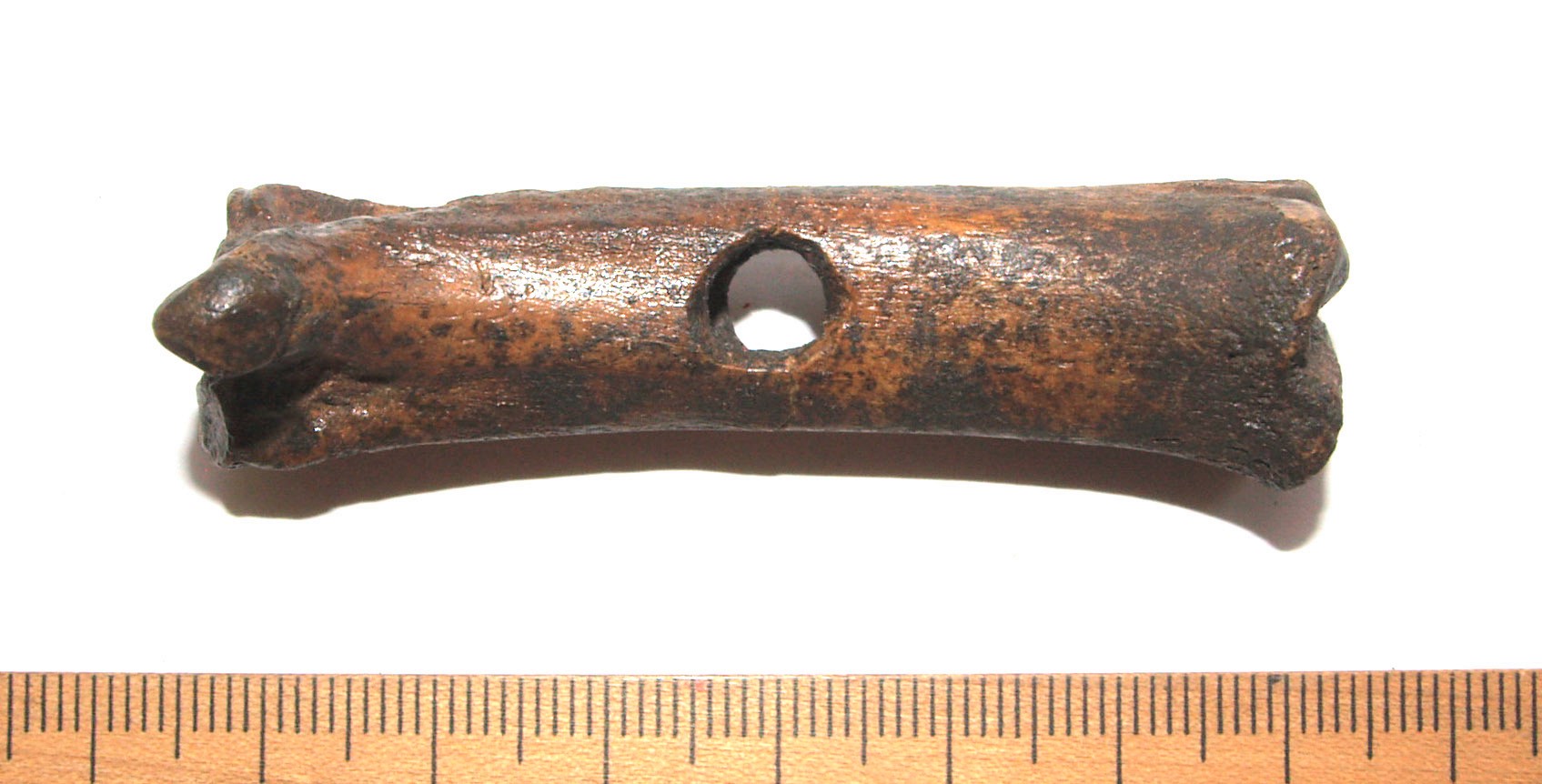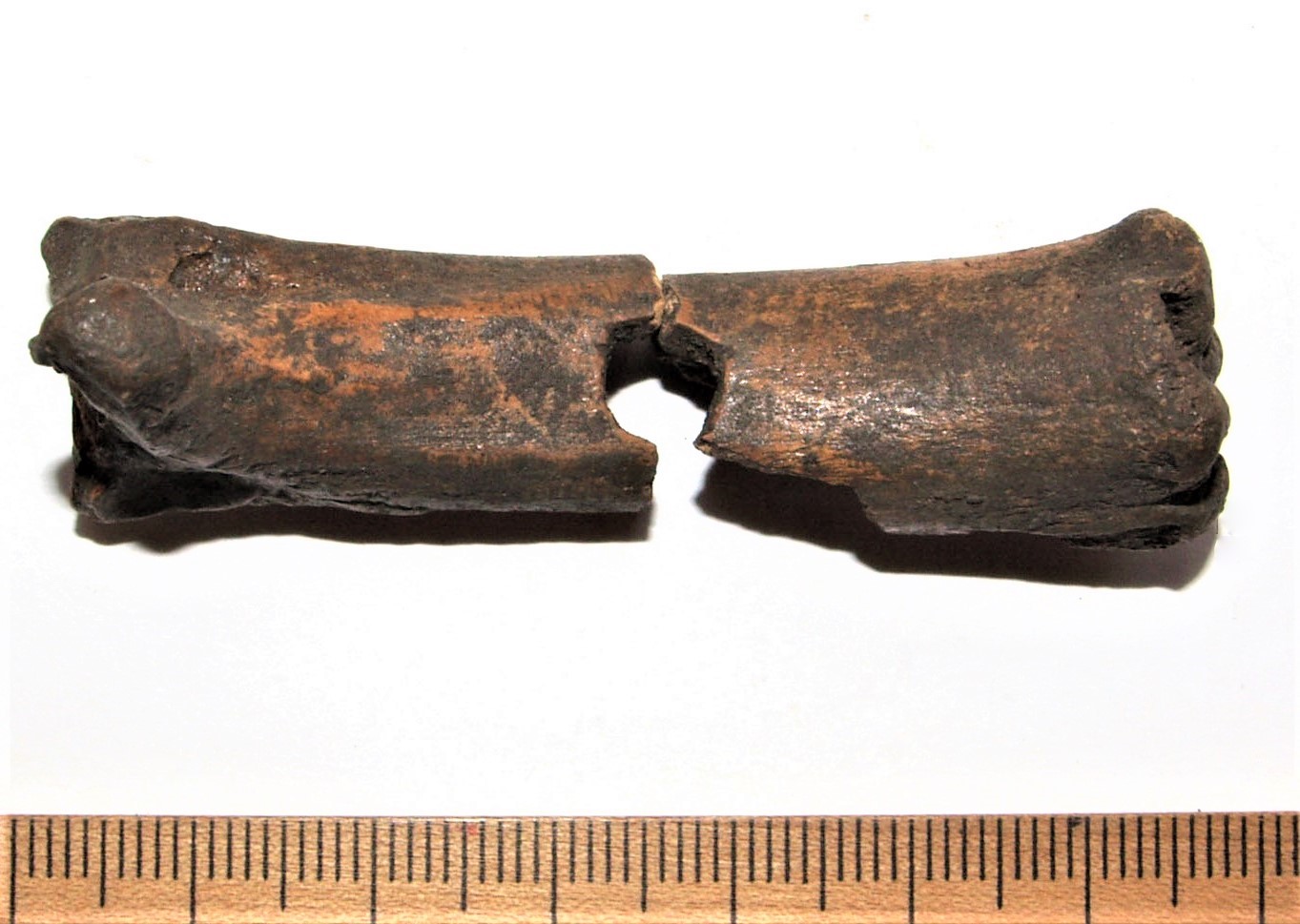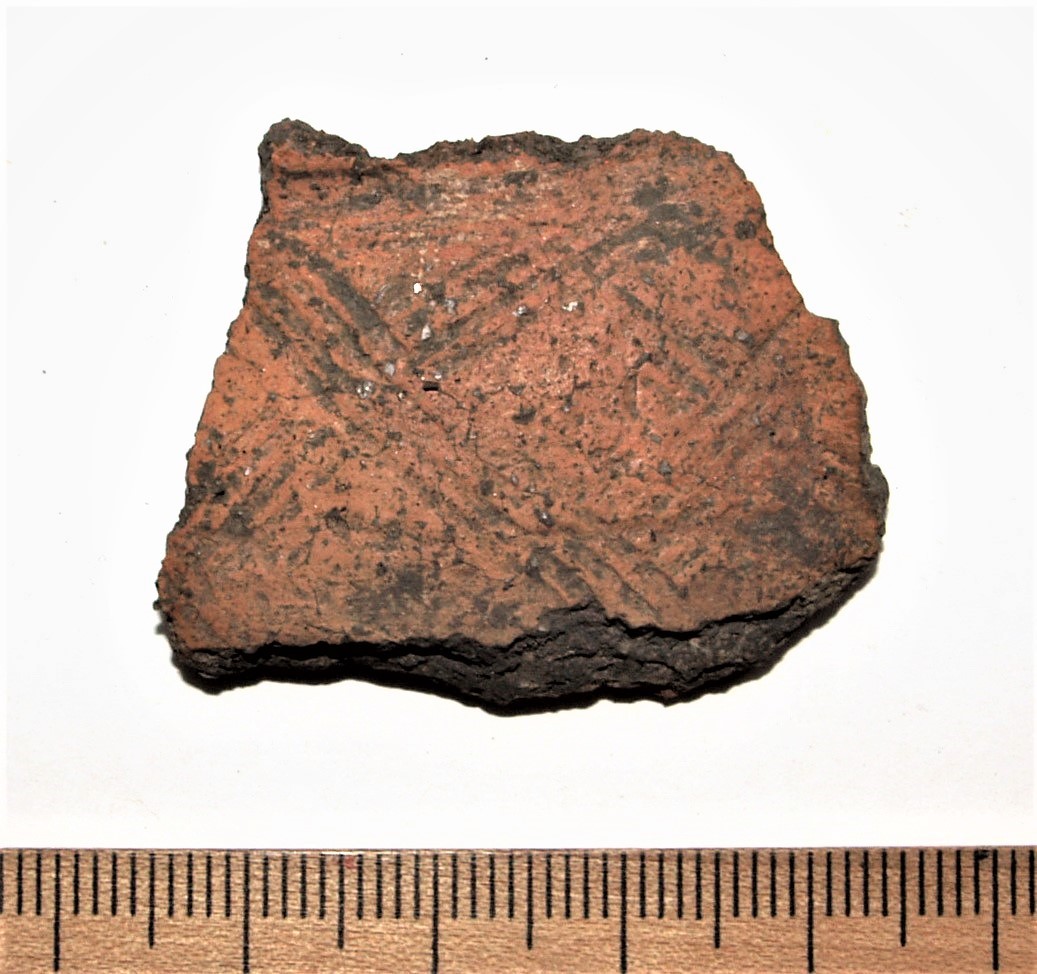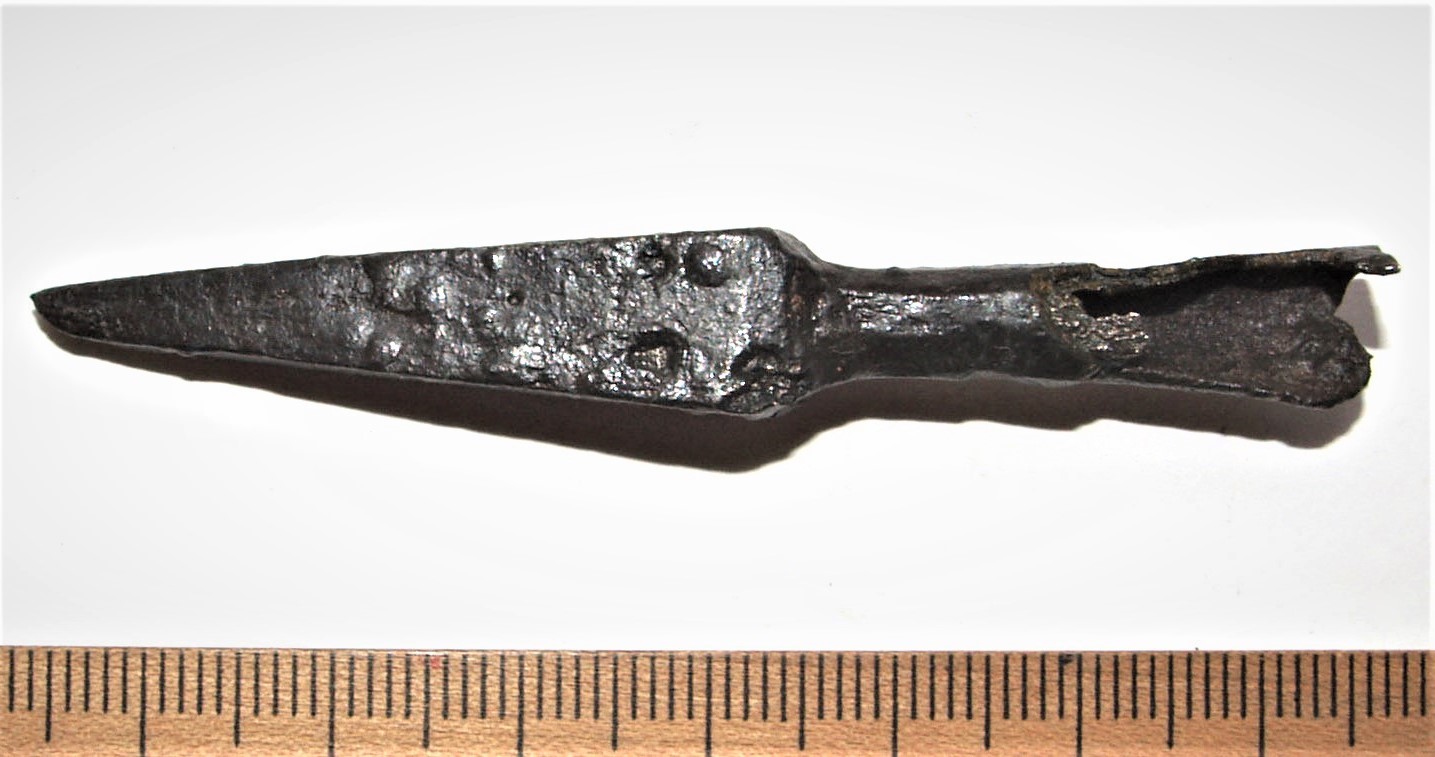Database
Our database is free to use for all history and archaeology enthusiasts. If you use our database, please do not forget to cite correctly:
Mägi, Marika; Palm, Piia Sandra. Archaeological Artefacts of Saaremaa. Foundation Osiliana / Tallinn University. Accessed: date.
The Osiliana Archaeological Database presents artefacts from Saaremaa and the surrounding small islands.
The database contains mainly Iron Age and Medieval finds that can be classified.
Undated metal or other pieces were generally excluded from the database.
Ceramics are represented by isolated examples.
The database is a work in progress and is constantly being updated.
Valjala hillfort
Penannular brooch with rolled terminals, copper alloy.
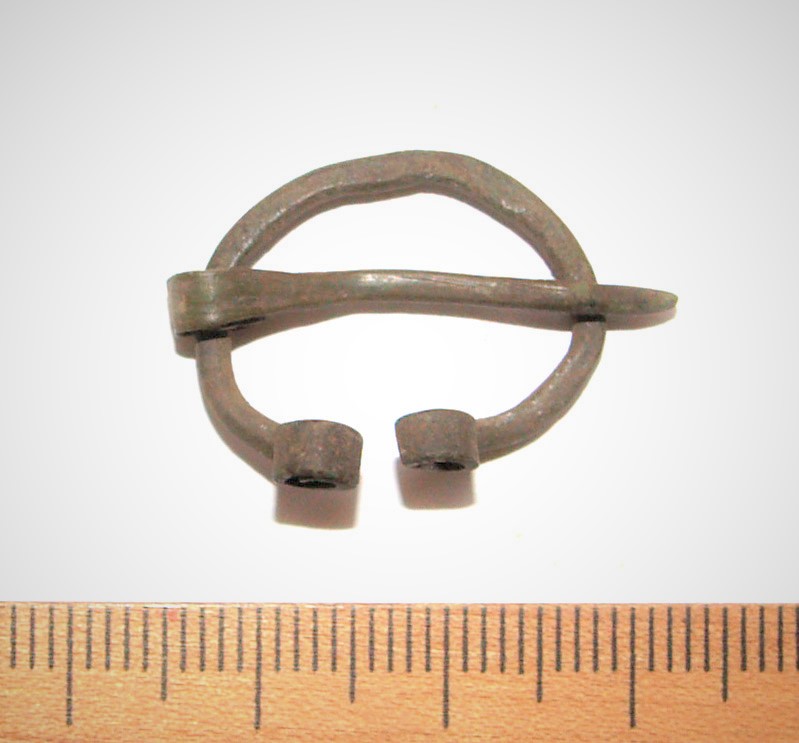

Penannular brooch with rolled terminals, copper alloy. Such penannular brooches were used during a longer period 800-1400. Here probably 1100-1400, according to other finds.
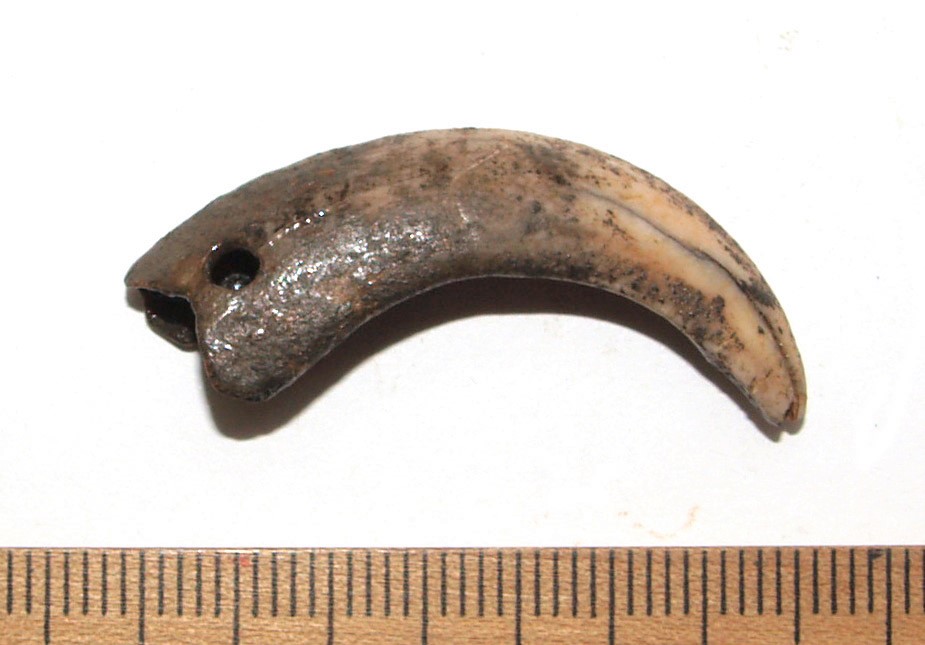
Tooth pendant.
Literature:
Luik, H. 2004. Luuesemed hilisrauaaja linnamägedel Lõhavere, Soontagana, Varbola ja Valjala leidude põhjal. – A. Haak, E. Russow, A. Tvauri (Toim.). Linnusest ja linnast: uurimusi Vilma Trummali auks = About hillfort and town: studies in honour of Vilma Trummal (157−188). Tallinn, Tartu: Eesti Teaduste Akadeemia Kirjastus. (Muinasaja teadus; 14). Read the article (ENG conclusion p. 185-188): here.
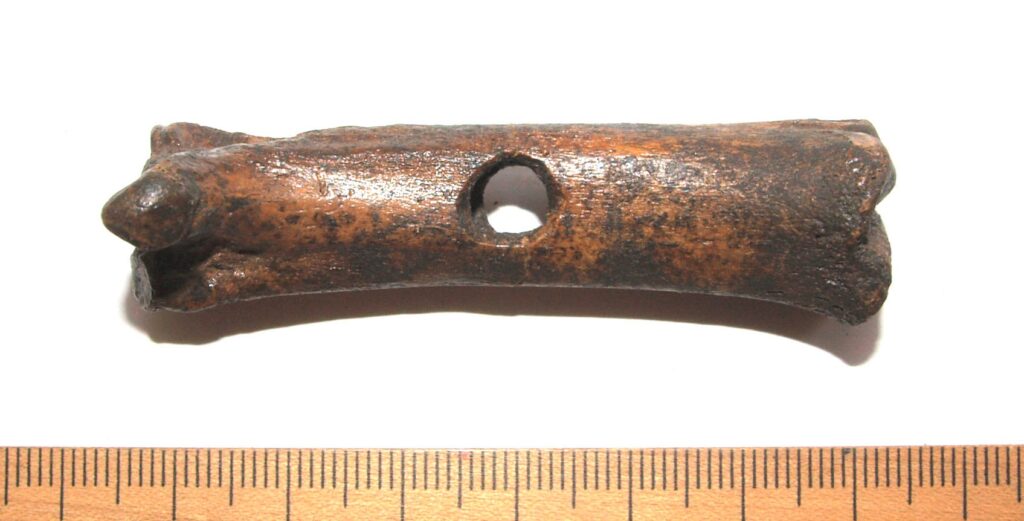
Bone toggle.
Literature:
Luik, Heidi. 2005. Luu- ja sarvesemed Eesti arheoloogilises leiumaterjalis viikingiajast keskajani. Tartu Ülikool, Filosoofiateaduskond, Ajaloo osakond. Tartu: Tartu Ülikooli Kirjastus. Read the thesis: here.
Luik, H. 2004. Luuesemed hilisrauaaja linnamägedel Lõhavere, Soontagana, Varbola ja Valjala leidude põhjal. – A. Haak, E. Russow, A. Tvauri (Toim.). Linnusest ja linnast: uurimusi Vilma Trummali auks = About hillfort and town: studies in honour of Vilma Trummal (157−188). Tallinn, Tartu: Eesti Teaduste Akadeemia Kirjastus. (Muinasaja teadus; 14). Read the article (ENG conclusion p. 185-188): here.
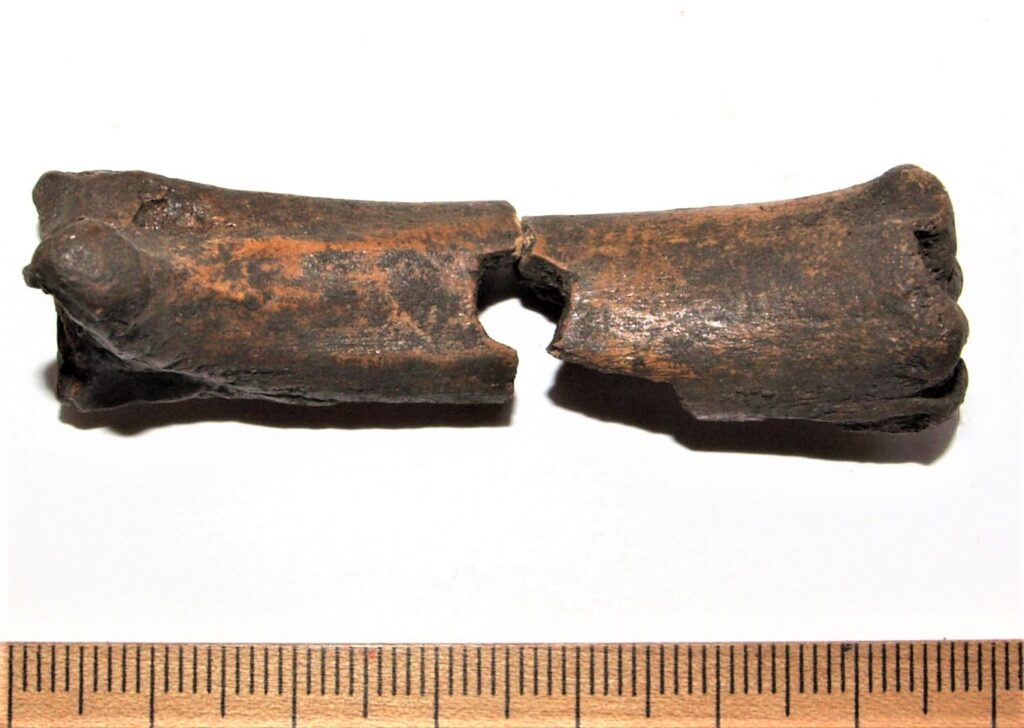
Bone toggle.
Literature:
Luik, Heidi. 2005. Luu- ja sarvesemed Eesti arheoloogilises leiumaterjalis viikingiajast keskajani. Tartu Ülikool, Filosoofiateaduskond, Ajaloo osakond. Tartu: Tartu Ülikooli Kirjastus. Read the thesis: here.
Luik, H. 2004. Luuesemed hilisrauaaja linnamägedel Lõhavere, Soontagana, Varbola ja Valjala leidude põhjal. – A. Haak, E. Russow, A. Tvauri (Toim.). Linnusest ja linnast: uurimusi Vilma Trummali auks = About hillfort and town: studies in honour of Vilma Trummal (157−188). Tallinn, Tartu: Eesti Teaduste Akadeemia Kirjastus. (Muinasaja teadus; 14). Read the article (ENG conclusion p. 185-188): here.
Haak, A.; Russow, E.; Tvauri, A. (Koost. ja toim.). 2004. Linnusest ja linnast: uurimusi Vilma Trummali auks = About hillfort and town : studies in honour of Vilma Trummal. Tallinn, Tartu: Teaduste Akadeemia Kirjastus, p. 157-188.
Valjala hillfort
Potsherd of a pot wall, hand-made ceramic, decorated with rhombic checker. Pots with very similar decoration have been found e g at Rahu stone grave near Valjala, or at Soontagana hill-fort in West-Estonia. Rhombic checker decoration on ceramic was characteristic for Saaremaa, West- and NW-Estonia, the here presented variant is mainly for Saaremaa.
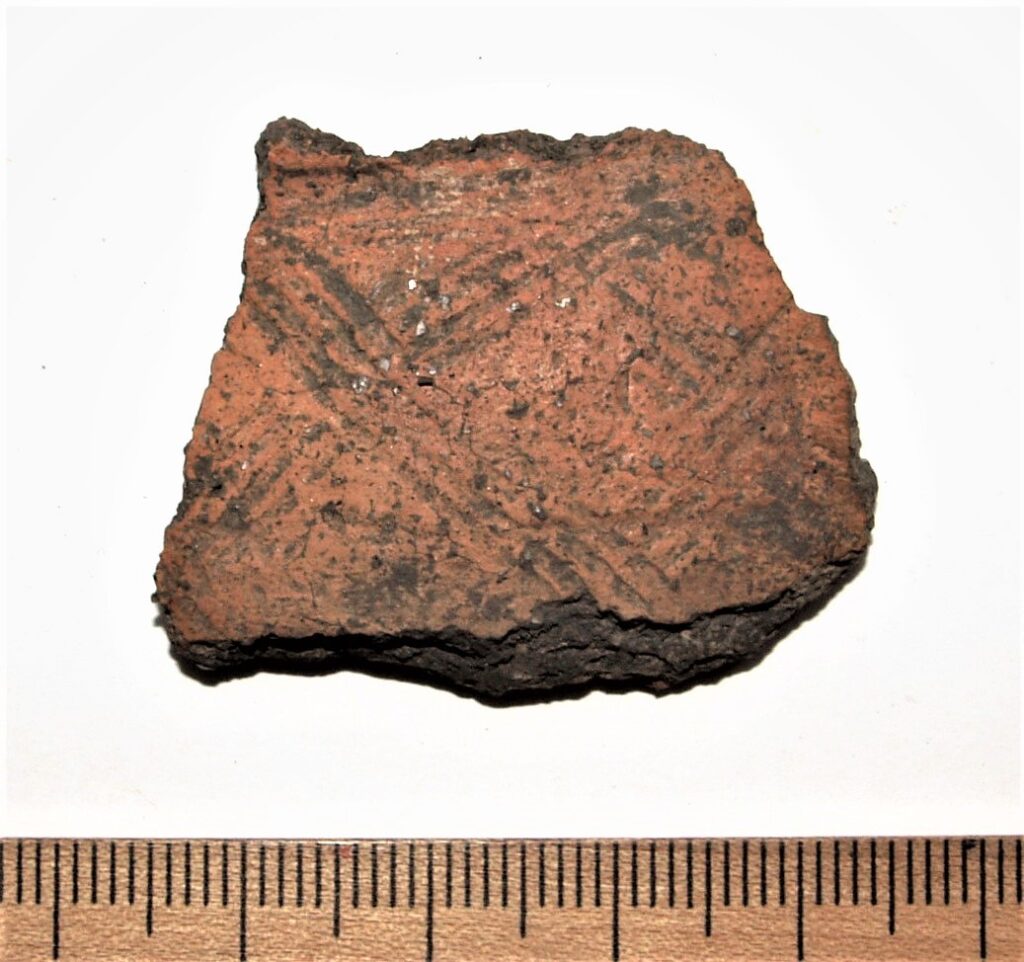

Potsherd of a pot wall, hand-made ceramic, decorated with rhombic checker. Pots with very similar decoration have been found e g at Rahu stone grave near Valjala, or at Soontagana hill-fort in West-Estonia. Rhombic checker decoration on ceramic was characteristic for Saaremaa, West- and NW-Estonia, the here presented variant is mainly for Saaremaa.
Literature:
Tvauri, A. 2005. Latest Iron Age Pottery In Estonia (from the 11th century to the middle of the 13th century). – Muinasaja teadus, 16. Tartu-Tallinn, 60-61, drawing 38: 1. Read the article (ENG p. 177-181): here.
Valjala hillfort
Drawknife or leather tanning tool, Dated according to the find contect.
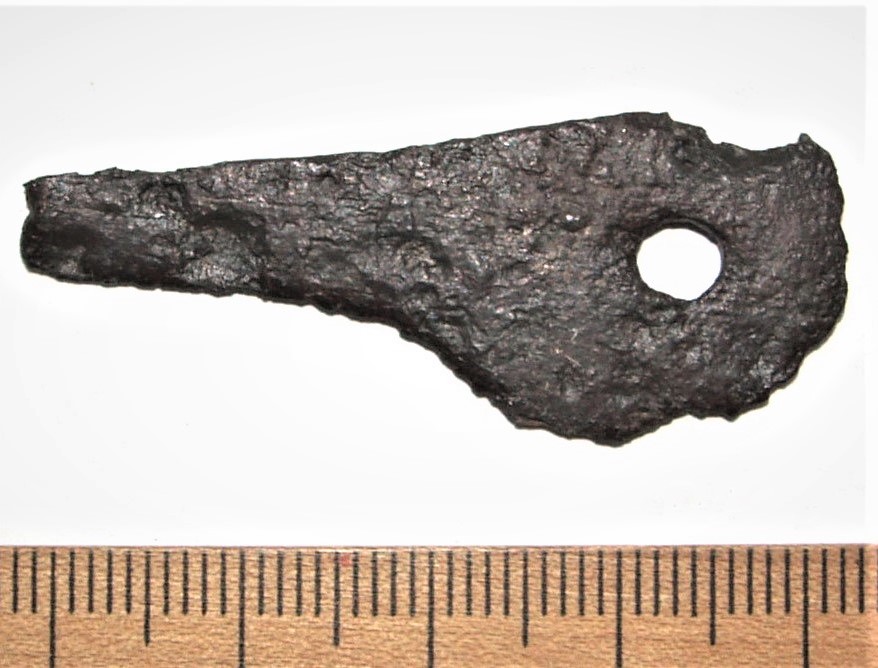
Drawknife or leather tanning tool (Vasks 2010). Dated according to the find contect.
Literature:
Vasks, A. 2010. Slīmests vai ādu apstrādes rīks. – Latvijas Vēstures Institūta Žurnāls, 2, 5–13.
Valjala hillfort
Penannular brooch, copper alloy. Thickening, grooved ring and lily-shaped terminals.
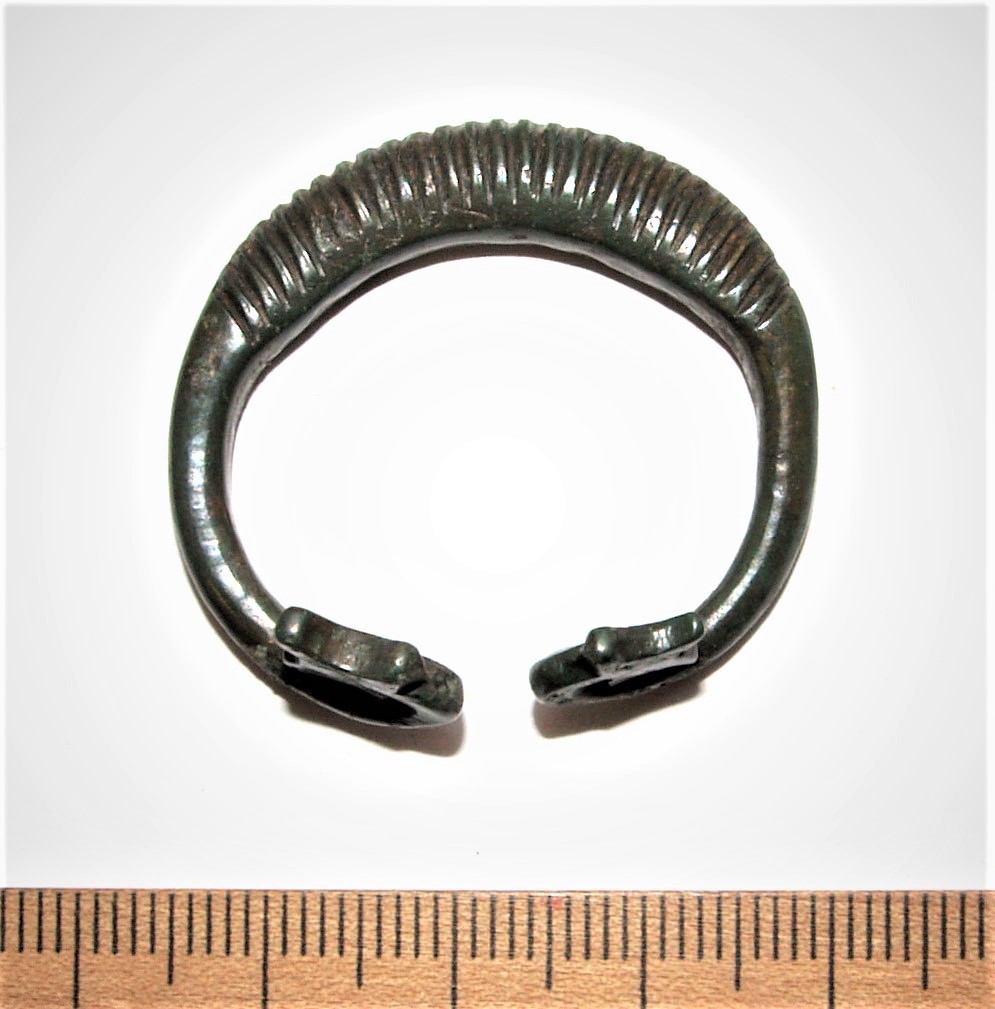
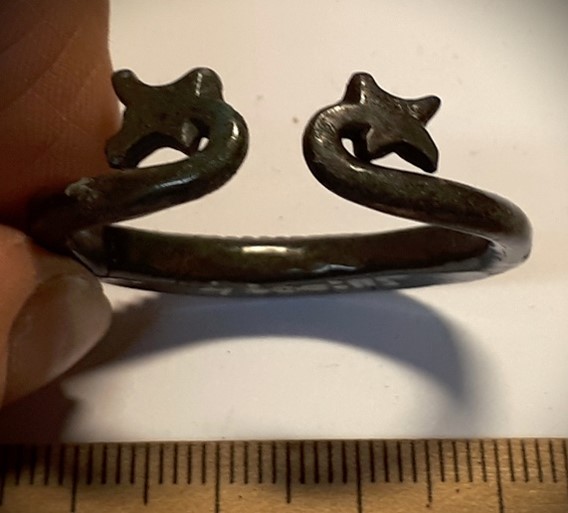
Penannular brooch, copper alloy. Thickening, grooved ring and lily-shaped terminals. Similar brooch was found in buril No 1 at Valjala churchyard in 1971 (Mägi et al 2019). Based on the shape of the ring, as well as similar brooches in inhumation graves in Couronia and in St Peter’s churchyard in Riga, the brooch can be dated to the 13th-14th century, although similar types were used until the third quarter of the 15th century (Vaska 2017, 62-64).
Literature:
Vaska, B. 2017. Rotas un ornaments Latvijā no 13.gs. līdz 18.gs. vidum. Latvijas Nacionālais vēstures muzejs. Rīga.
Mägi, M.; Malve, M. & Toome, T. 2019. Early Christian burials at Valjala churchyard, Saaremaa. – Archaeological Fieldwork in Estonia 2018, 93−118, 94. Read the article: here.
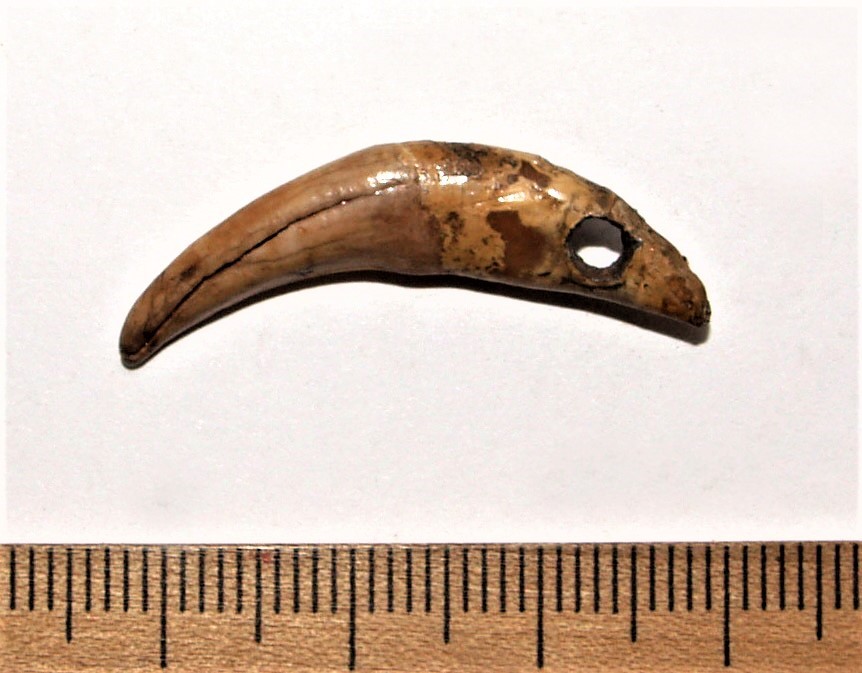
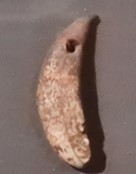
Tooth pendants.
Literature:
Luik, H. 2004. Luuesemed hilisrauaaja linnamägedel Lõhavere, Soontagana, Varbola ja Valjala leidude põhjal. – A. Haak, E. Russow, A. Tvauri (Toim.). Linnusest ja linnast: uurimusi Vilma Trummali auks = About hillfort and town: studies in honour of Vilma Trummal (157−188). Tallinn, Tartu: Eesti Teaduste Akadeemia Kirjastus. (Muinasaja teadus; 14). Read the article (ENG conclusion p. 185-188): here.
Valjala hillfort
Crossbow bolt, iron. Crossbow bolt with a pyramid-shaped tip.
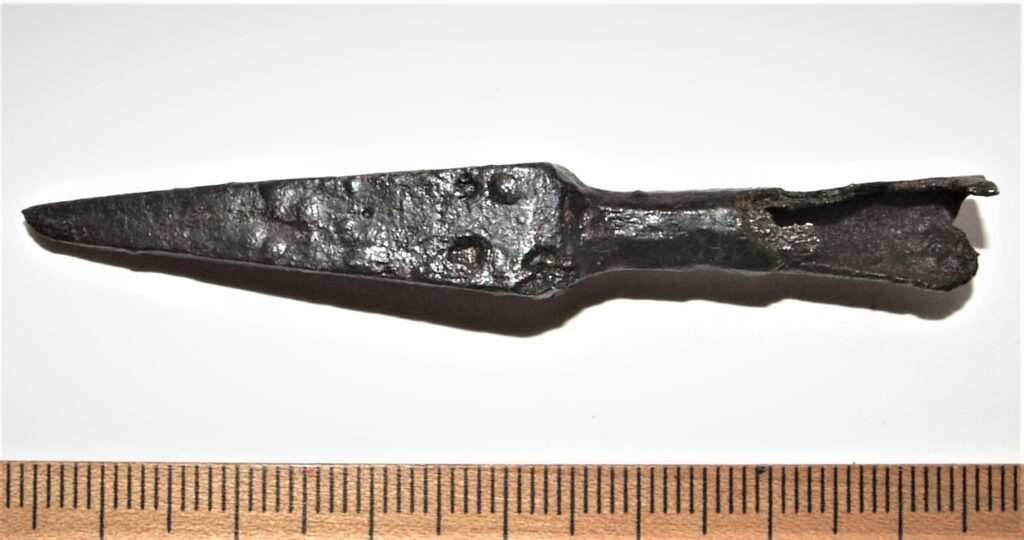
Crossbow bolt, iron. Crossbow bolt with a pyramid-shaped tip. The bolt has a wider part at the base, just before the socket. Mäesalu´s type A I. Compare with similar ones e g at Varbola hillfort (e g AI 3864: 1, 5299: 23, 305). Crossbow were taken into use in the Eastern Baltic as early as in the end of the 12th century, but heads of such type are in Estonia dated mainly to the first half of the 13th century (Mäesalu 1991). In Latvia they are datef from the end of the 12th century to the early 14th century (Mugurēvičs 2008, 202).
Literature:
Mugurēvičs, Ē. 2008. Viduslaiku ciems un pils Salaspils novadā. Rīga, 112, 202.
Mäesalu, A. 1991. Otepää linnuse ammunooleotsad. – Eds. L. Jaanits & V. Lang. Muinasaja teadus, 1. Agu, Tallinn.
The negative value refers to time Before Christ.

